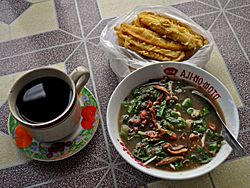Bubur pedas facts for kids

Bubur pedas served with pisang goreng and a cup of coffee served in Sambas, West Kalimantan, Indonesia.
|
|
| Type | Porridge |
|---|---|
| Course | Main course |
| Place of origin | Indonesia |
| Region or state | Sambas and Sarawak |
| Created by | Malays |
| Serving temperature | Hot |
| Main ingredients | For bumbu: Garlic, ginger, shallots, onions, dried chilli, turmeric, lemon grass, galangal and grated coconut For bubur: Carrots, potatoes, leafy greens, mushrooms, bean curd, bamboo shoots, turmeric leaves, long beans, dried shrimp and meat are added along with seasoning |
Bubur pedas is a special kind of porridge that comes from the Malay people. You can find this traditional dish in Sambas, which is in West Kalimantan, Indonesia, and also in Sarawak, Malaysia. It's often served during Ramadan, especially when Muslims break their fast at iftar time.
What's in Bubur Pedas?
Bubur pedas is made with finely ground rice that has been lightly cooked, and also with grated coconut. The base of the porridge is usually a rich broth. This broth can be made from bony meat, like ribs, or from chicken broth.
To give it its unique flavor, many spices are added. These spices, called bumbu, include shallots, garlic, red chili pepper, and lemongrass. Other spices like black pepper, galangal, and salam leaf (which is like an Indonesian bay leaf) are also used.
Lots of fresh vegetables are mixed into the porridge as it cooks. These can include carrots, water spinach, fern leaves, and kesum leaves. You might also find long beans, bean sprouts, bamboo shoots, and diced sweet potatoes.
When the spicy porridge is ready to be served, it's often topped with crispy fried shallots, anchovy fish, and peanuts. Some people like to add a squeeze of Key lime juice, a drizzle of sweet soy sauce, or a dollop of sambal chili paste for extra flavor.
Where Does Bubur Pedas Come From?
This special porridge first came from the Malay people living in Sambas, which is located in West Kalimantan. Over time, the recipe traveled and became a popular dish for the Sarawak Malays as well.

